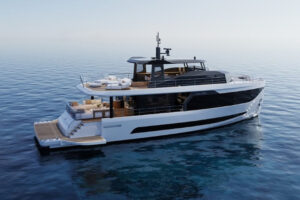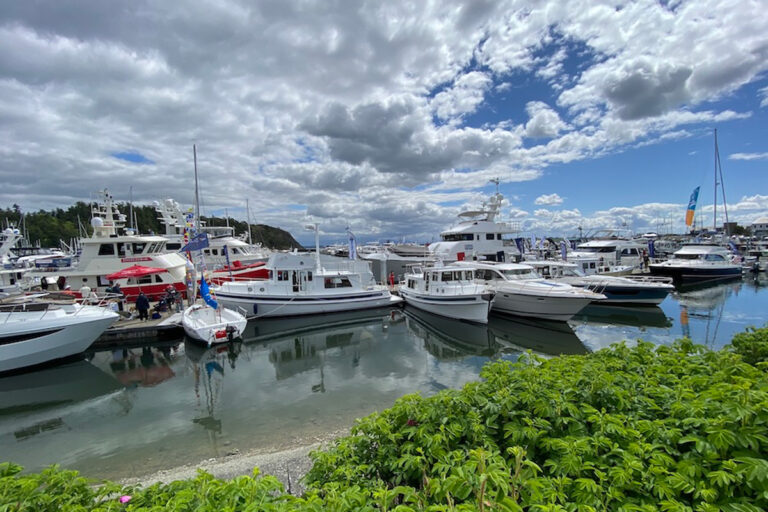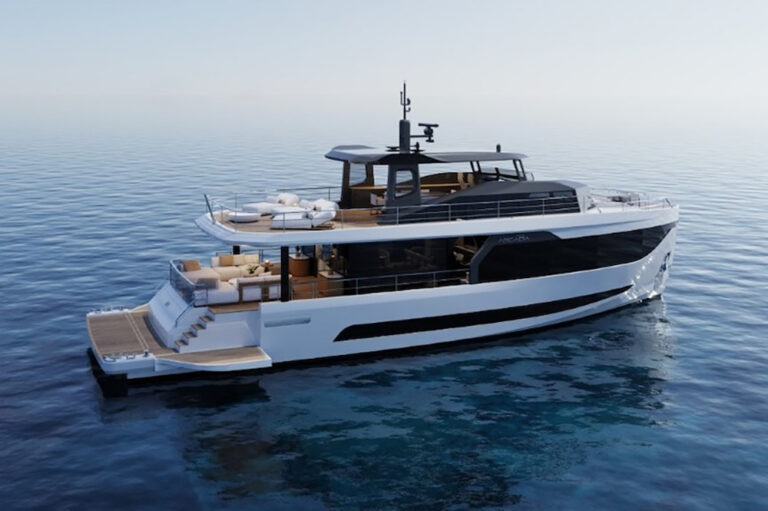An Italian businessman and his wife, having sailed their standard production Baltic 58 cruising yacht for a few seasons and graduated to a 67-foot custom design, decided in 1998 that they wanted the ultimate performance cruising sloop.
Their vision would become the new Baltic Custom 78 cruiser/racer Aledoa 5, a performance-oriented yacht in which comfort and technology play a key role. Reichel/Pugh designed her, continuing the bloodline begun by the firm’s 90-foot Leopard of London (“The Catbird Seat, April 2001). Like Leopard, Aledoa 5 is a sleek, all-carbon one-off fitted out to a high level of luxury and specialist equipment.
Baltic Yachts of Finland built her to the owners’ exacting specifications.
“I am not motivated by racing. I simply have no desire to be sailing a bus”, the businessman said. “We will not be competing in any regattas this year, but we do spend around 100 days each year simply cruising. I like boats that are fast and responsive, and everything on board has to be perfect.”
That’s a short enough brief, but the detail must have led to a good deal of head-scratching for John Reichel and Jim Pugh, as well as the R&J design/engineering team within Baltic. Within the small text was a determination from the owner and his wife that the canting keel machinery should not intrude into the yacht’s interior at all.
Swinging a 12-ton lead bulb through a 70-degree arc some 12 feet below the waterline requires a considerable amount of engineering. On other boats, the hydraulic rams that control this movement protrude well up inside the hull to minimize the loads. On Aledoa, however, these had to operate below the level of the cabin sole within what are, in cruising design terms, extremely shallow bilges. Indeed, movement of the pivot arm was limited to little more than 1 foot, 6 inches on either side, forcing the team to explore several options to compare weight, stability and performance implications before determining the best method.
The result is a brilliant piece of engineering that works simply and soundlessly at the press of a button, pulling the boat over by 18 degrees when she’s at rest.
This is more useful than sailors might first consider. In Aledoa‘s case, it was an essential piece of kit just to get out of her berth in Antibes, where she was sandwiched between the 100-foot-plus motoryacht Gitana and the two-masted classic schooner Altair. Altair’s spreaders, protruding 1 foot, 6 inches outboard of her beam, would have blocked Aledoa‘s path had she not had the ability to heel to the opposite side.
Party tricks aside, this swing-keel concept offers distinct benefits. When winds are slight, the keel can be canted over to leeward upwind and down to give the rig sufficient heel to fill the sails and stop their flogging. As the wind speed climbs, the keel is canted progressively up to windward to counter the heeling forces from the rig. Between the 20 and 35 degrees, this precision-milled foil loses an increasing amount of lateral resistance, so the boat is equipped with a central carbon daggerboard just forward of the mast.
Whereas Leopard uses water ballast to replace a soccer squad on the weather rail, Aledoa‘s canting keel provides the same righting benefit without the performance-sapping penalty of carrying 4 to 6 tons of water in side tanks.
The result is a 78-footer that sailed effortlessly at 11 knots in just 8 knots of breeze during our test off Antibes.
Aledoa‘s teak decking, central guest cockpit with large dinette, cushioned sunpads and minimalist layout of winches, tracks and lines make her a good cruising yacht, yet nothing is quite what it seems.
The teak decking is actually a 1/4-inch veneer over an ultralight (and strong) carbon composite deck molding. The solid-looking teak cockpit dinette is a veneered carbon copy, supported on titanium legs. The Rondal hatches, which provide much of the natural light belowdecks, are flush with the deck, a concept carried forward to the anchor, which swings up and over the bow on a hydraulic arm from within a hidden locker. The windlass, too, pops out from within the deck only when its push-button control is activated. The fairleads around the gunwale also hide away when not in use.
Like the windlass, all the winches and sheets are hydraulically powered and controlled at the push of a button to minimize the physical aspects of sailing.
Below, the companionway opens into a saloon that makes the most of this yacht’s 18-foot beam. A large dinette to port and a sofa arrangement opposite allow for entertaining a large number of guests comfortably.
Despite the size of the saloon, Baltic packed a remarkable amount into this 78-footer. There is a fully equipped galley to port with a nav station opposite. Two double guest cabins are on either side of the mast with separate heads and a shared shower stall.
The master stateroom is beneath the central cockpit, which limits headroom above the double bed, but that is the only compromise in a layout that includes yet another twin-bed guest cabin adjacent to the skipper’s well-found berth.
The cook and deckhand share a cabin close to the bows, accessed via a foredeck hatch.
None of this counters all the costly weight savings made in the hull construction. Like the deck above, every bit of satin teak is a veneer bonded to carbon/Nomex sandwich panels. The weight savings are considerable.
Consider the doors. A solid plywood panel would weigh about 48 pounds. A Baltic carbon one looks exactly the same but weighs just 17 pounds. Such construction throughout Aledoa‘s interior saved about two-thirds of the weight normally found within such lavish interiors.
Although happy, Aledoa‘s owner is already thinking about his next custom design.
“I would like a boat with a canting keel that can be raised up about 33 inches inside the hull”, he said. No, not so he can explore shallower anchorages, but because reducing draft between 2 and 3 feet would reduce drag by a significant amount when sailing downwind.
“That would make quite a speed difference”, he said.
The success of Aledoa, combined with Baltic’s embracing of luxurious high-performance yachts, recently spawned a 147-foot Reichel/Pugh custom design for an American owner. She is expected to displace less than 100 tons, half that of contemporary cruising designs, and should cruise effortlessly at 20 knots.
Baltic also has orders for two Judel/Vrolijk 145-foot custom cruising yachts being built to lower standards of composite engineering than Aledoa for European owners.
Contact: Baltic Yachts USA, (401) 846-0300; info@balticyachts.com; www.balticyachts.com. Baltic Yachts Italia, (011) 39 0584 387948; info@balticyachts.it; www.balticyachts.it. Baltic Yachts Ltd., (011) 358 6 781 9200; info@balticyachts.fi; www.balticyachts.fi.








